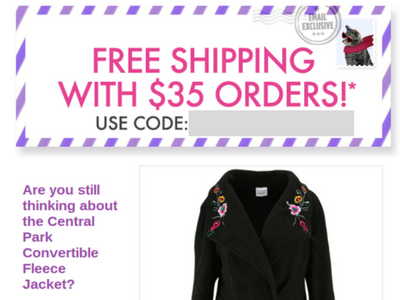I hate checkups at the doctor's office. It's the kind of tedious thing that drives me nuts. Then I complain to the nurse about doing tests and she says "Are you seriously going to complain about this?".
And then I feel foolish.
Sometimes we procrastinate (or complain loudly) about the mundane things that are important to us. Of course, my health is important. I should just suck it up and act like a big girl.
It's the same thing with your choice of eCommerce systems. Maybe you set up your eStore last year and never looked back. Maybe you're making steady sales and believe you're all set.
Or maybe you're letting profits slip through your fingers every single day.
To make sure your eStore is performing at peak condition, here're five simple questions to help you start this year's eCommerce checkup:
Am I Using an Abandoned Cart Strategy?
Every single eStore, regardless of size, needs an abandoned cart strategy. This is a no-brainer. According to the Baymard Institute, an estimated 70% of online consumers leave filled shopping carts. That never means you've lost 70% of your sales. It just means that you have to work a little longer to recapture these lost sales.
A lot of eCommerce providers have some sort of abandoned cart option that lets you send gentle reminders or special offers. GreaterGood's Animal Rescue site sent me the following email the day after I left something in their shopping cart: Still Thinking? Let Us Sweeten The Deal! and offered me free shipping.
And I bought the item that day. Who can pass up free shipping?
Am I Paying Too Much?
Not all eCommerce providers are the same. Never assume they charge the same price. Plus, there are many eCommerce options including sales widgets that are free but charge a standard fee per sale. Or you may have your own stand-alone eStore or be part of a larger marketplace (like Etsy, Ruby Lane or eBay). There are many choices in the eCommerce universe.
The fee for each PayPal transaction is 2.9% plus $0.30 USD of the amount you receive. Etsy charges a listing fee of $0.20 USD plus a transaction fee of 3.5% of the displayed price (there may be additional shipping costs depending on your location). Shopify's Basic Plan is $29 per month plus 2.9% and 30¢ per transaction.
There're a lot of variables. Look at how much you are spending each month and if there are any cheaper options you could use instead.
Where Can I Add New Sales Options?
The world of eCommerce is always evolving. New technology comes out and creates entirely new profit streams. Or some formerly popular choices seem antiquated. That's why it's essential to see where you could add a sales options and what gives you the best chance for sales. Knowing this helps you determine where you should spend the majority of your time, effort, and marketing budget.
Many eCommerce providers now have the ability to add a sales option directly into YouTube videos.
Here's an example from Selz:
Or maybe you want a Facebook store or an Instagram store (Facebook owns Instagram so you can easily make an Instagram store using a business Facebook page). There are many, many places to sell online. Make sure you're focusing on the right options for your business.
Am I Making the Right Tax Choices?
First, I know you're thinking "No! Don't make me think about taxes!"
But understanding taxes can be a huge issue for online businesses that sell in the European Union. The EU has a value added tax (VAT) that applies to any business in the world, regardless of whether or not your business is based in the EU. It's been a nightmare for many online realtors both inside and outside of the EU.
For non-EU companies:
"For companies based outside the EU, there are a number of import taxes such as VAT and duty to consider - how much is due is calculated on the value of the goods. The EU valuations rules need to be understood. However, the fundamental issue is 'who is the Importer of Record' and therefore responsible for the payment of all import taxes - you, the supplier, or your customer?"
Do not worry if this stuff gives you headaches. Remember Brexit? It's stuff like this that drove the UK out of the EU in the first place. But you don't have to worry about figuring out VAT if you have the right eCommerce provider as many take care of this tax situation for you (some for free and some as a paid service).
Ask your eCommerce company about the EU VAT. Let them handle this ridiculous issue for you or find an eCommerce service that offers VAT management as a benefit.
What's My Checkout Process Like?
Shoppers don't want to wait. They don't want a lengthy checkout process. We live in an instant gratification world. Shoppers simply want to press a button and get their stuff.
Blame Amazon with their incredibly useful buy now button.
Make sure your checkout process isn't difficult, frustrating or challenging. If your eCommerce provider doesn't have some type of "buy now" button, give consumers a clearly marked and direct route to the "confirm order" button.
Go through the entire process yourself. Compare it to your competitor's checkout process. Do everything in your power to streamline this incredibly important aspect of any online business.
Can I Add an Upsell Option?
Have you ever bought movie theater popcorn and not been offered a larger size for just a little more? Movie theaters understand the power of upselling. Who can resist an extra large for a $1 more?
Adding an upselling offer is a simple and powerful way to increase sales. Just remember it's not another step in the sales process, as upselling needs it's own strategy.
Keep it simple, straightforward, and logical. Don't forget it's very easy for customers to click away from your site at any point. Create a system that flows and makes sense to your customer. See what types of upselling or even cross-selling options your eCommerce provider offers and take advantage of these opportunities to increase your profitability.
eCommerce is Connected to Everything
Don't put off performing your yearly eCommerce checkup. The time you spend analyzing, testing and evaluating your eCommerce system can save money and increase profits. Never be satisfied with a system. And never assume your system is the best and can't be improved.
Maybe the thought of an eCommerce checkup isn't the sexiest thing you could do with your day. Maybe you'd rather spend your time focused on creating new products or connecting with customers. Just remember that everything in your business is connected. The bottom line is you can't make a sale unless your eCommerce system works.
So suck it up and perform your eCommerce checkup. Your business's overall health will thank you for it.


